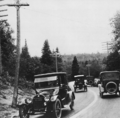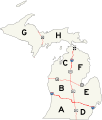Michigan Highways
The State Trunkline Highway System of the US state of Michigan is a network of roads owned and maintained by the Michigan Department of Transportation (MDOT). The most prominent of these roads are part of one of three numbered highway systems in Michigan: Interstates Highways, US Highways, and the other State Trunklines. Other systems of roads are operated by the 83 counties in the state as well as each city.


Interstate Highways and US Highways are assigned at the national level. Interstate Highways are numbered in a grid—even-numbered highways are east–west highways (with the lowest numbers along Mexico and the Gulf of Mexico), and odd-numbered highways are north–south highways (with the lowest numbers along the Pacific Ocean). US Highways are also numbered in a grid—even numbered for east–west highways (with the lowest numbers along Canada) and odd numbered for north–south highways (with the lowest numbers along the Atlantic Ocean). For this reason, mainline (two-digit) Interstate Highways in Michigan all have numbers above 69 and mainline US Highways all have numbers below 45. Three-digit Interstate and U.S. Highways, also known as "child routes," are branches off their main one- or two-digit "parents". The Interstate and US Highways are maintained by MDOT. Interstate 75 (I-75) and US Highway 23 (US 23) are the longest examples in the state.


State Trunklines are the other state highways maintained by MDOT. These highways are completely owned and maintained by the state. Michigan highways are properly referred to using the M and never as "Route 28" or "Highway 115", but as M-28 or M-115. The marker used for state trunklines is a diamond with a block-letter "M" at the top. Roads that are maintained by the state but not assigned a state trunkline designation carry an unsigned highway designation.


County-Designated Highways are assigned numbers in a zone system by MDOT, but maintained by the counties. Each zone is indicated by a letter A–H which is followed by a number based on a grid inside that zone. Each county also maintains any other roadway that is not a state trunkline or a city street. The numbering and signing practices vary from county to county, as does the size of each county's system. Numerical designations typically do not carry over from one county to the next; a CDH that crosses county lines keeps its designation in each county however. County road designations are typically abbreviated "CR" or "Co Rd" followed by the number, and CDHs are abbreviated to just their letter and number assignment.
The Interstate Highways in Michigan are the segments of the national Dwight D. Eisenhower System of Interstate and Defense Highways that are owned and maintained by the U.S. state of Michigan, totaling about 1,239 miles (1,994 km). The longest of these, Interstate 75 (I-75), is also the longest highway of any kind in the state. On a national level, the standards and numbering for the system are handled by the Federal Highway Administration (FHWA) and the American Association of State Highway and Transportation Officials (AASHTO), while the highways in Michigan are maintained by the Michigan Department of Transportation (MDOT) and the Mackinac Bridge Authority (MBA). The Interstates in Michigan have their origins in World War II-era expressways built in the Detroit area. After the system was created in 1956, the state highway department completed its first border-to-border Interstate in 1960. The last highway was completed in 1992, giving Michigan a total of 13 Interstate freeways. The original allotment of mileage to Michigan which would receive federal funding was expanded in 1968, and the United States Congress designated an additional highway in the 1990s that has not yet been built.
There are also 26 current business routes that connect cities bypassed by the Interstates; 23 are business loops that connect on both ends to their parent highway, and three are business spurs that connect on only one end. I-496 has the Capitol Loop as its connection to the Michigan State Capitol in downtown Lansing. Another six business routes have been designated but are either no longer signed or maintained as state highways. (Full article...)General images
Selected picture

Topics
State Trunkline System, overview of the system
- Interstates Highways in the state
- US Highways in the state
- State Trunklines
- County-Designated Highways in the state
- Pure Michigan Byways, a system of scenic, historical or recreational highways in the state
- Great Lakes Circle Tour
Subcategories
Related portals
WikiProjects
Things to do
Nominations and votes for selected articles and selected pictures are always needed. Anyone can nominate an article, and anyone can vote for an article. You can also recommend items for Did you know?. Improvements to the articles are always welcome as the project works on expanding and nominating the remaining ones for Good Article or Featured Article status.




























